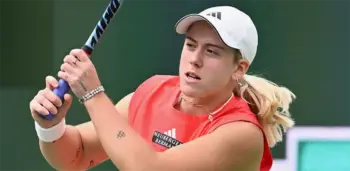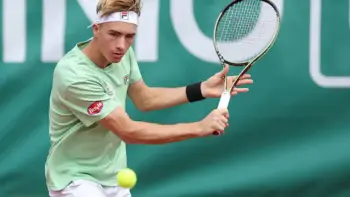Tennis has been played at colleges across the country since before the National Collegiate Athletics Association was formed. Even by 1906, when the NCAA was formed, tennis was still seen as an elite sport and, at this point, still reserved for the upper classes. This all changed in the early 1920s when tennis became recognized by the NCAA. This opened the sport up to less regarded colleges that would begin to succeed and, in turn, increase the popularity of the sport amongst colleges.
The first national champion was generated by Harvard University. He won the first-ever U.S. Open in 1881. At the time, the competition was held at the Newport Casino in Newport, Rhode Island. In the competition’s inaugural year, only members of the United States National Lawn Tennis Association could enter. Richard Sears won the first title and to this day still holds a record seven men’s singles titles, at the U.S. Open, joint with William Larned and Bill Tilden, who are both also American. Winning the first round of the original U.S. Open set Sears off on an 18 match unbeaten run, which lasted until 1887 when he retired.
Success for College Tennis Players
The sport has continued to flourish since that day 140 years ago, and if you were to look through the men’s singles draw for the 2020 U.S. Open you would find 14 former collegiate men’s players preparing to play in the first round of the tournament. This list included the likes of former NCAA singles champion Bradley Klahn from Stanford University and Kevin Anderson who played tennis for the University of Illinois. Anderson reached the finals of Wimbledon after taking part in the second-longest match in Grand Slam history. The semifinals match against John Isner lasted six hours and 36 minutes this sent Anderson to a career-high ranking of five. John Isner also came from an American college – he attended the University of Georgia who has racked up eight national champions in their time in college tennis.
Successes like this are possible due to the expansion of the sport since the early days. Colleges are offering better and better facilities every year as they hope to attract the best and brightest young tennis stars from around the world. The list of community colleges with tennis teams is growing too. In 2015 Tennis magazine put Baylor University in Texas at the top of its best facilities. Three other Texas schools joined them. This is a big stride for the collegiate sport as they begin to shake the idea that tennis is only for the elite upper class. Collegiate tennis should be seriously considered by young tennis players. It offers a way into a very competitive and expensive sport.
Players have to consider enormous costs for the coaching staff, court fees, and travel expenses, that’s without considering equipment and tournament fees. This can all be bypassed when you join a college team. Most colleges will have their own courts and you’ll be a part of a team of around 12 other students with a team of college coaches. Being part of a school sports department means you will be in a program that has anticipated a schedule of at least 20 dual matches against other college teams in the spring, as well as invitational singles tournaments and other preparation events alongside regular training which fits in with your school schedule. They will also usually cover travel expenses for their athletes. It would take a heavy investment to cover all of these costs for at least four years before a young athlete is ready to enter at ATP tour level.
Should College Athletes Get Paid?
This leaves the question about whether collegiate tennis players should be paid. Of course, some students enter college with a tennis scholarship, but this is not an option for everyone as it requires meeting athletic and academic specifications that not everyone can meet. This can often mean that student-athletes are not only attending classes, submitting work on time, training, and competing but also working to support themselves through college. The issue of paying college athletes has been discussed at dinner tables around America for years. The argument is usually surrounding college football. The demanding schedule for a college footballer or tennis player leaves very little time to earn some money. Needless to say, students themselves also feel passionate about it, addressing this question in “why college athletes should be paid” essay projects, creating petitions, and the like.
Some people argue they have less need for money because the university offers the best gyms to workout in, free health insurance for injuries, transportation, food, equipment, and most importantly for some free tuition. Their images are also often used for promotional purposes and are of financial benefit to the college. In some cases, college sports are broadcast and bring in huge viewership, with college athletes not seeing a single cent of those earnings appearing in their personal bank accounts.
The arguments against this suggest it is not in the spirit of education to pay the students. College should be seen as a service provided by the state. A place where you train to be a professional, whether that is an archaeologist or as a footballer/tennis player. We got to college to train or to learn to become the professionals we are later in life. That’s what the NCAA provides. Athletes play at the college level, and they further use that experience at the professional level where they will be paid just like if they’d studied accounting. The difference is playing for a college team generates money for a school where studying English Literature does not.
The Future of College Tennis
It is certainly an argument that will continue while little changes occur, such as allowing college athletes to benefit from the use of their name, image, and likeness. One thing which cannot be argued with, however, is that tennis has grown under the NCAA and will continue to grow. More and more colleges of all different statures are investing in their in-house courts or teaming up with local sports centers and investing in their tennis training facilities. Collegiate tennis has become an option for all American students, and in the long run, this is only likely to benefit the sport as a whole.

















working on a long ago ??? about the first college rulebook that was a tad different than the usta rules? it is a big deal to me!
I played tennis in hs and college back in 1965 until 1970s and thought we alwaysjust used the older rules from usta !
please guide me thru the history of the rules of college that changed from itf, or usta!
thx for your time!